#Wholesale New Year's Eve Costumes
Explore tagged Tumblr posts
Text
https://blog.wholesaleconnections.com/steps-to-grow-wholesaler-business-of-new-years-eve-costumes/

Steps To Grow Wholesaler Business Of New Year's Eve Costumes
Grow your UK Wholesaler Business of New Year's Eve Costumes now with the top Online Wholesale Store In Manchester, UK.
#Wholesaler Business#Online Wholesalers UK#UK Wholesale Supplier#Online Wholesale Store#Wholesale New Year's Eve Costumes
0 notes
Text
https://blog.wholesaleconnections.com/steps-to-grow-wholesaler-business-of-new-years-eve-costumes/

Steps To Grow Wholesaler Business Of New Year's Eve Costumes
Grow your UK Wholesaler Business of New Year's Eve Costumes now with the top Online Wholesale Store In Manchester, UK.
#Wholesaler Business#Online Wholesalers UK#UK Wholesale Supplier#Online Wholesale Store#Wholesale New Year's Eve Costumes
0 notes
Text
https://blog.wholesaleconnections.com/steps-to-grow-wholesaler-business-of-new-years-eve-costumes/

Steps To Grow Wholesaler Business Of New Year's Eve Costumes
Grow your UK Wholesaler Business of New Year's Eve Costumes now with the top Online Wholesale Store In Manchester, UK.
#Wholesaler Business#Online Wholesalers UK#UK Wholesale Supplier#Online Wholesale Store#Wholesale New Year's Eve Costumes
0 notes
Text
https://blog.wholesaleconnections.com/steps-to-grow-wholesaler-business-of-new-years-eve-costumes/
Steps To Grow Wholesaler Business Of New Year's Eve Costumes
Grow your UK Wholesaler Business of New Year's Eve Costumes now with the top Online Wholesale Store In Manchester, UK.
#Wholesaler Business#Online Wholesalers UK#UK Wholesale Supplier#Online Wholesale Store#Wholesale New Year's Eve Costumes
0 notes
Text
How Are UK Wholesalers Growing Sales This New Years Eve?

Learn more about UK Wholesalers and how they grow their sails not just on New Year's Eve but on other occasions too and how you can do the same too.
#UK Wholesalers#Online Wholesalers#Online Wholesalers UK#Wholesale Womens New Years Eve Costumes#Womens Wholesale New Years Eve Costumes And Accessories
2 notes
·
View notes
Text

Hypes On Womens Costumes Offered By UK Wholesaler
#UK Wholesalers#Online Wholesalers UK#Wholesale Women Costumes#Wholesale New Years Eve Costumes#Online Wholesale Store In Manchester UK
1 note
·
View note
Text
Hypes On WomenGet Wholesale Womens Costumes And Accessories online at inexpensive prices from the top Online UK Wholesalers Store In Manchester UK.s Costumes Offered By UK Wholesaler
#UK Wholesalers#Online Wholesalers UK#Wholesale Women Costumes#Wholesale New Years Eve Costumes#Online Wholesale Store In Manchester UK
0 notes
Text
Wonder Woman: Earth One, Vol 2 - Part 1
I’m going to break this into a few parts, because it turned out I had a bit to say. I’ll start with my overall impressions, then dive into the spoilery recap.
General thoughts: Next verse, same as the first.
Grant Morrison purports to want to explore Marston’s ideas, but he’s more interested in the kooky, kinky trappings than the sentiment behind them.
Marston was radical and progressive in his time. Writing in the 1940s, he told his readers that women were men’s equals — and even superiors! — in every way. He told young girls there was no limit to what they could do. His stories promoted love over hatred, peace over violence, rehabilitation over retribution.
If Morrison had taken that bold sentiment and reimagined it through a lens of modern society and feminism in 2018, he might have had a compelling story to tell. Instead, he takes Marston’s ideas as he understands them and transplants them wholesale into a time in which they’re no longer radical and progressive, but rather backward and out-of-step with modern intersectional feminism, and then proceeds to ask such deep, incisive questions as “yes but realistically could we actually replace all world governments with a matriarchy?????”
He never truly deconstructs any of Marston’s ideas, just parrots phrases like “submission to loving authority” a lot and raises questions without ever making a decent attempt at answering them. To be fair, part of the problem is that he’s simply trying to do too much at once: juggling parallel stories in Themyscira and Man’s World, an interrogation of the Amazons’ philosophies and the introduction of three new antagonists and the tensions they cause, all within a limited page count, Morrison is unable to devote the necessary time to properly developing any of them. It’s no wonder the result is so half-baked.
But hey, just throw in a bunch of vagina planes and a dusting of kink and watch as everyone crows over how subversive he is.
Yannick Paquette’s artwork is still beautiful. His page layouts are still dynamic and expressive, and his character designs are still lovely. Diana in particular gets a variety of very cool outfits, including a beautiful modest costume for a trip to the Middle East.
But he still can’t shake his tendency towards drawing women’s bodies in weirdly-contorted poses with bizarre pornfaces. Wonder Woman shouldn’t look like she’s orgasming as she’s leaping into battle, ffs.
Oh, and the series is still being edited by noted serial sexual harasser Eddie Berganza. HASHTAG FEMINISM!
Let’s get into the recap.
Content warning for some skeevy mind control content and general discussion of the gender essentialist, body-shaming, TERFy attitudes of Morrison’s Amazons.
The story opens with a flashback to 1942, with Paula von Gunther leading a Nazi invasion of Themyscira, and god I’m already so tired.
idk, I mean, I get that Nazis were a major Golden Age antagonist, and Morrison is harking back to that. But there’s a broader historical and cultural context to consider. Cartoonish Nazi villains in patriotic WWII-era American comics carried very different associations than they do in 2018, in the midst of a presidency steeped in white supremacy and hate speech, on the eve of a midterm election in which a record number of neo-Nazis are standing for office, at a time when hate groups are surging, when migrant children are being separated from their families and held in detention camps— just. Not a time when I want to be reading about cartoonish super-Nazis, personally.
And I don’t really see why they necessarily need to be this story? The battle serves to illustrate how Amazons combat and… “rehabilitate”… their adversaries. Paula ultimately serves as a plot device. Couldn’t that maybe have been achieved without Nazis?
Anyway, Paula announces that she is claiming the island for the Third Reich, and Hippolyta is like “lol no”.
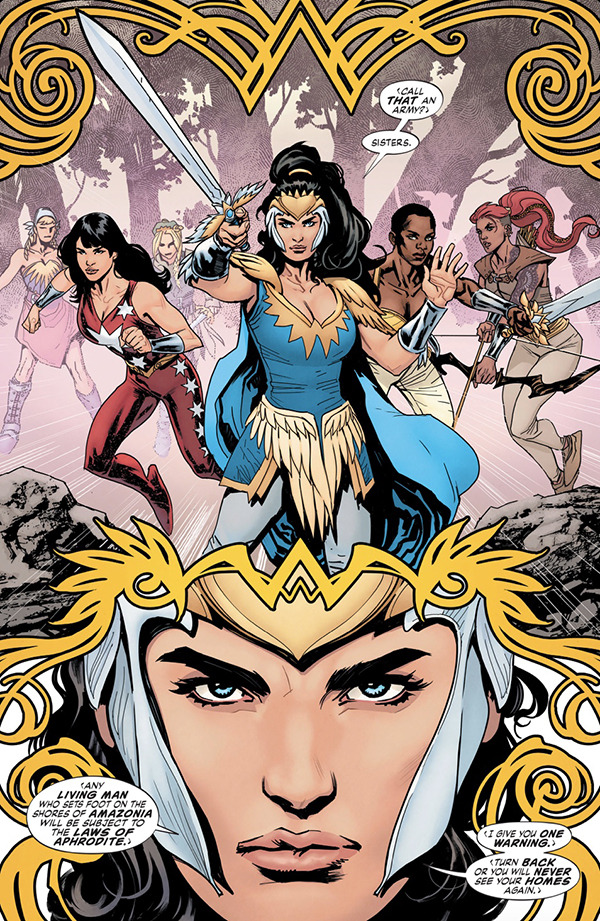
Okay, that part I like. Evil army storms the island, backed by guns and warships, surround a half-dozen barely-armed women… who all but roll their eyes. ‘Pfft, children. Fine, if you want to play this game…’ And the evil army can only gape in bewilderment as the women proceed to take them apart in minutes.
But this is where it gets weird.
The Amazons fire a purple ray at all of the Nazis, which… makes them all drop their weapons and start screaming “YES!” orgasmically?

Hippolyta tells Paula that the soldiers “will be taken to the Space Transformer. They will be transported to Aphrodite’s world where Queen Desira and her butterfly-winged Venus Girls wait to purge them of their need for conflict. They will be taught to submit to loving authority. They will learn to embrace peace and obedience. They will be as happy as men can be.”

Paula attacks Hippolyta, rips off her magic girdle and heaves a great boulder over her head— wait, were we supposed to know that Paula had superpowers? That seems like something that should have been flagged.
She effortlessly takes down the Amazons who rush to the queen’s defence and takes a moment to cackle villainously. “Behold the pride of Germany! The ultimate daughter of the thousand-year-empire of Adolf Hitler!” To which Hippolyta— okay, I like this part, too.

Hippolyta calmly gets to her feet and puts Paula in a stranglehold. “We are the Amazons of myth, my dear! I am Queen Hippolyta eternal.” She swiftly and efficiently brings Paula to her knees.
But, welp, never mind, it’s about to get fucking creepy again.
Hippolyta forces Paula into “the Venus Girdle”, a device that “charges every body cell with vitalising currents and harmonises the brain, encouraging obedience.”

Paula: Let me go! What is that? What are you doing? Hippolyta: The Venus Girdle? It charges every body cell with vitalising currents and harmonises the brain, encouraging obedience. A dainty thing, is it not? Paula: I won’t— I won’t— You can’t control me— you can’t— can’t make me— make me... oh… make me…
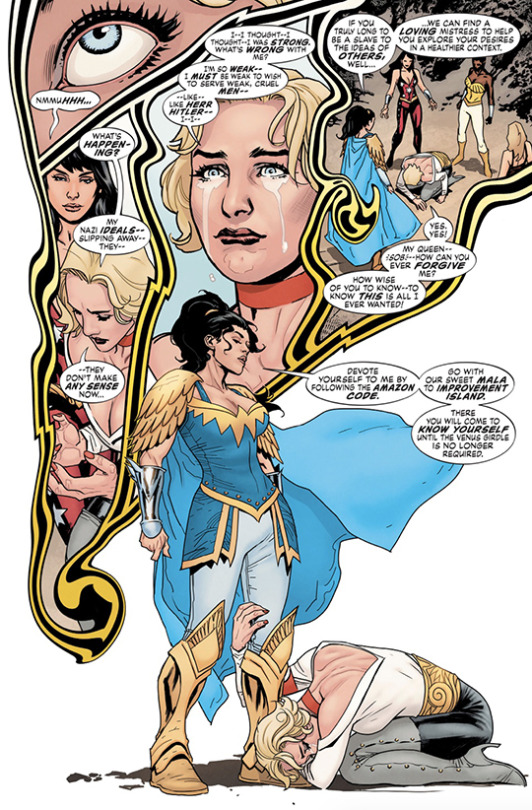
Paula: nmmuhhh… What’s happening? My Nazi ideals— slipping away— they— they don’t make any sense now… I— I thought— I thought— I was strong. What’s wrong with me? I’m so weak— I must be weak to wish to serve weak, cruel men— like— like Herr Hitler— I— I— Hippolyta: If you truly long to be a slave to the ideas of others, well… we can find a loving mistress to help you explore your desires in a healthier context. Paula: Yes. Yes! My queen— [sob] —how can you ever forgive me? How wise of you to know— to know this is all I ever wanted! Hippolyta: Devote yourself to me by following the Amazon Code. Go with out sweet Mala to Improvement Island. There you will come to know yourself until the Venus Girdle is no longer required.

Paula: But all I want is to serve you, my queen! I love you! Please don’t turn your back on me!
Basically, Hippolyta forcibly uses a mind-altering device on Paula that alters her brain chemistry to make her placid, compliant and suggestible, then immediately washes her hands of her.

So… let’s talk about this, because I think it strikes at the heart of the problems with Wonder Woman: Earth One.
Queen Desira, the Venus Girls, magnetic golden Venus Girdles that “harmonise the brain” — all these things are drawn from Golden Age Wondy comics cowritten by Marston and his collaborator Joye Kelly. Marston played with mind control a lot in his stories, and not all of it came from the bad guys.
Morrison’s bold, subversive approach to these story elements is to export them wholesale into the present day and force us to feel uncomfortable about them.
In other words, he’s taking some of the weirder and more fucked up story elements from a collection of comics that are widely agreed to be very weird, and then plonking it before your readers and asking, ‘hey guys, have you ever considered… that this might be weird and fucked up???’
There’s nothing clever or insightful about that. And there’s certainly nothing groundbreaking about a cis white male writer imagining a fictitious feminist dystopia where women strip away men’s free will.
Like, if you really want to be subversive with Marston’s Wonder Woman, how about you start by hiring a woman to write it? Why not see what this iconic feminist hero conceived by a cis white man in the 1940s and written almost exclusively by cis white men for over 75 years might look like if she were reimagined and reinterpreted by LGBTI women, by women of colour? By the women left out of those original comics?
That would be subversive. Morrison is just being a smartarse.
So yeah, Hippolyta turns her back on the helpless, brainwashed, lovesick Paula and walks over to Diana, who’s defied her mother’s orders and run down from the palace to get a glimpse of the action. She’s full of questions; Hippolyta brushes them off with the usual (for Morrison’s Amazons) ‘men are shit’ line.
There’s a moment where Paula and Diana meet eyes from across the beach, and each asks, “who is she?” Diana is simply curious; Paula is instantly lovestruck.

Paula: That girl… the image of my queen.
This looks like foreshadowing, but spoilers: it goes absolutely nowhere.
Sidenote: If the Amazons deal with invaders by brainwashing them, why did they want to kill Steve Trevor in Volume One?
Cut to present-day America, where a room of faceless men discuss the threat posed by the Amazons and their superior technology, which they assume extends to deadly weaponry. The only in they have with the Amazons is Wonder Woman, and to get through her defences they’ve called in “an expert in female psychology”, aka a misogynistic monster.

Doctor Psycho: Gentlemen. She may be strong and tough and smart and beautiful… but she’s just a woman. I never met one I couldn’t break.
Oh, goody.
Cut to a cute splash page of Diana playing baseball. She gets a lot of great outfits in this book.

She’s also clearly making an impact in Man’s World; her face is plastered across every magazine, and people flock to hear her speak.
A Q&A sessions serves as a thinly-veiled opportunity for Morrison to answer some of the criticisms of the first book. His response leaves something to be desired.
“Amazon training can make any of you into a Wonder Woman,” says Diana. We teach a system of physical and psychological health and vitality. The grace and beauty of Aphrodite, the skill and wisdom of Athena.”
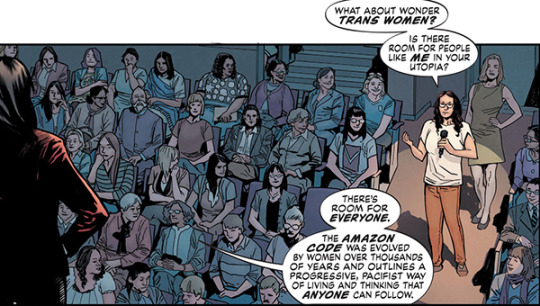
Woman: What about Wonder trans women? Is there room for people like me in your utopia? Diana: There’s room for everyone. The Amazon Code was evolved by women over thousands of years and outlines a progressive, pacifist way of living and thinking that anyone can follow.
I’m sorry, but that’s a fucking bullshit answer. It’s a weak, superficial gesture towards inclusiveness that conspicuously fails to express any real support or solidarity.
And depressingly, this is 100% in-character for Earth One Diana, because Morrison’s Amazons? are absolutely TERFs. As with the mind control content, Morrison has exported Marston’s 1940s binaristic gender essentialism unchanged into the 21st century in order to ask searing questions like ‘hey but what if??? the idea that women are genetically more suited to ruling??? is simplistic and flawed?????’ But the most he’ll engage with the genuinely insidious implications around the exclusion of trans and nonbinary people is a smiling noncommittal, ‘Are trans people welcome? My friend, everyone is welcome! No further questions!’
Morrison’s Wonder Woman displays a profound disregard of context. He ignores not only the cultural, historical and individual contexts that shaped the original 1940s Wonder Woman, but also the contexts of the time in which he’s currently writing and the cultural space that Wondy has come to inhabit today as a feminist and LGBT icon.
Removed from context, Morrison is simply taking a hero who traditionally hails from an advanced utopian society, taking another look at the views that society actually espouses, and reframing her as a well-meaning but naive hero from an advanced but deeply flawed and unsettling society.
In context, he’s doing exactly what Brian Azzarello did in turning the Amazons into murderous man-hating monsters, just with more kink and vagina planes.

Woman 2: Umm, there’s a lot of stuff on social media about how you dress provocatively and promote an unrealistic body type, which is basically setting a bad example for women. I mean, the stuff you do is amazing and all, it’s just… does any of the criticism bother you? Diana: I don’t think there’s any such thing as an ‘unrealistic’ body shape. My own body is the result of diet, exercise and… um… sophisticated genetic engineering. Otherwise, I dress as I please.
Volume One made it clear that all Amazons have the physique of supermodels, and when they encounter the diverse body types of the women in our world, they are disgusted and respond with body-shaming insults. Here, Diana again avoids voicing any actual support (she doesn’t say that all women’s bodies are beautiful and valid, she suggests that her body type is not unrealistic), while also throwing out eugenics as a reason for the lack of body diversity among the Amazons. Oh good, I was hoping we’d get more Nazi parallels!
Finally, a militant white feminist stands up and observes that if the Amazons are capable of half of what Diana says they are, then they could dismantle the patriarchy overnight — so why is Diana wasting time giving philosophy lectures? “You can control people’s minds with that lasso of yours. Like you did with that dude on TV— so why can’t you put a lasso ‘round the whole world?”
Afterwards, talking to Beth Candy, Diana’s like, ‘gosh, Beth, I’ve never seriously thought about world domination before, but maybe it is time to consider stripping all mortals of their free will, dismantling all nations and compelling everybody on the planet to bow down before Amazonia.’
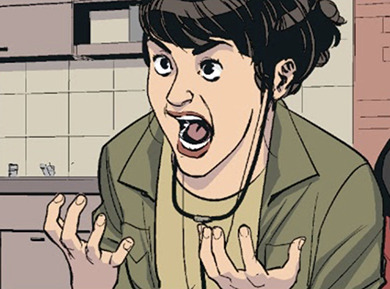
Then Diana gets on her mental radio and calls her mother, confessing her doubts about her mission.
It was around this point in the book that the Amazons’ dialogue began to grate on me. I couldn’t put my finger on what it was at first. Every line read like a ceremonious pronouncement. They used antiquated syntax and words, like “whole systems … must o’erturned be” and “she did, without due caution, this, her island home, depart!”. Even Diana would become infected with it whenever she was speaking to them. It felt like they weren’t so much conversing as they were reciting…
...verse…
oh my god, that motherfucker.
Surely he hadn’t.
I scanned the dialogue again. I double-checked it.
He had.
Grant Morrison, that obscenely pretentious wanker, wrote all of the Amazons’ dialogue in dactylic hexameter.
For fuck’s sake.

After finishing her call with Diana, Hippolyta learns that somebody has vandalised one of the temples with the symbol of “a backward-turning sun”, i.e. a swastika. Unseen by everybody, Paula breaks into Hippolyta’s palace.
23 notes
·
View notes
Text
https://blog.wholesaleconnections.com/hypes-on-womens-costumes-by-uk-wholesaler/

Hypes On Womens Costumes Offered By UK Wholesaler
Get Wholesale Womens Costumes And Accessories online at inexpensive prices from the top Online UK Wholesalers Store In Manchester UK.
#UK Wholesalers#Online Wholesalers UK#Wholesale Women Costumes#Wholesale New Years Eve Costumes#Online Wholesale Store In Manchester UK
0 notes
Photo
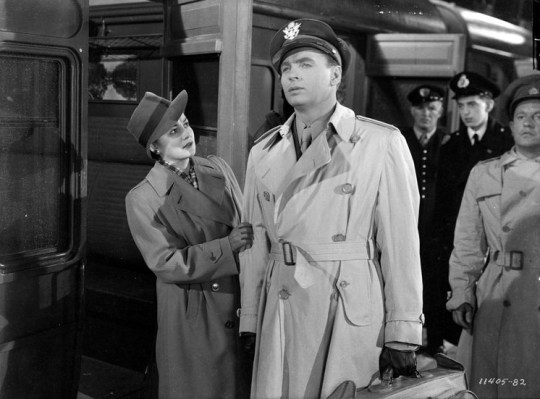
To Each His Own (1946)
When Olivia de Havilland passed away at 104 years of age last July, she was one of the last-surviving major stars of Hollywood’s Golden Age. The Golden Age mostly corresponds to the Hollywood Studio System in place at the time. In that system, studios contracted actors, directors, screenwriters, composers, costume designers, cinematographers, and more – sometimes loaning their personnel out to other studios. Before making To Each His Own, de Havilland sued her previous employer, Warner Bros., for unlawfully suspending her after she rejected a role as well as adding six months to her contract because of the suspension. De Havilland won her court case and the De Havilland Law remains in Californian law books today. But a furious Jack Warner retaliated, conspiring with other Hollywood executives to blacklist De Havilland by calling the actress “difficult” to work with.
For three years de Havilland went without work in Hollywood. During that time, she busied herself with productions of Lux Radio Theatre, volunteered at the Hollywood Canteen, and entertained American troops in the Pacific theater as part of a USO tour. Nevertheless, as one of the best-regarded actresses in Hollywood even before Warner’s blacklisting attempts, she was too good an actress for producers not to be interested in her services. In 1945, after signing a two-film deal with Paramount, de Havilland began work on a star vehicle for her, the melodrama To Each His Own. De Havilland enjoyed the screenplay by Charles Barckett (1939’s Ninotchka, 1950’s Sunset Boulevard) and Jacques Théry (primarily a novelist; 1942’s Joan of Paris), but believed it could be improved with revisions and a director she had confidence in. Her first choice for director was Mitchell Leisen, who guided de Havilland to an Academy Award nomination in the romantic drama Hold Back the Dawn (1941). Leisen reluctantly agreed to take up the project but, as de Havilland started developing her character as the production progressed, he knew he had a worthwhile production on his hands. He was right, and so were de Havilland’s instincts – To Each His Own may not distinguish itself technically, but the acting and revised screenplay elevate this melodrama.
Somewhere in London, a middle-aged American woman named Josephine “Jody” Norris (de Havilland) is walking the city’s blacked-out streets (as mandated by the government) on New Year’s Eve. It is World War II, and Jody volunteers herself some nights to be a fire warden. On this holiday evening, only she and Lord Desham (Roland Culver) are in the office. After some persuasion from Desham, the two head out for tea. While at tea, Jody learns a Gregory Piersen is arriving in London on a late train. Immediately, she leaves teatime with Lord Desham and dashes to the train station. There, in flashback, we learn that Jody was the daughter of her pharmacist father (Griff Barnett) in a small town named Piersen Falls. During World War I, a dashing U.S. Army Air Service fighter pilot Bart Cosgrove (John Lund in one of two roles) visits for a bond rally. Unexpectedly, and without anyone suspecting a thing, they fall in love. After hearing Bart has perished overseas, and a pregnant Jody decides to have and raise their child. She attempts to choreograph her own pregnancy, delivery, and first days of motherhood by making it appear as if she has “adopted” her own baby – all to avoid local scandal. An unfortunate twist of fate means that she will have to surrender her son, Gregory (nicknamed “Griggsy”), and watch him grow without the knowledge of his true parents.
Also starring in To Each His Own are Mary Anderson as Corinne Piersen, Phillip Terry as Alex Piersen, Bill Goodwin as Mac Tilton, Virginia Welles as Liz Lorimer, and a sassy Victoria Horne as Nurse Daisy Gingras.
Released in the spring of 1946, one can imagine how audiences might have viscerally reacted to the film’s setting. Through the Second World War, American audiences flocked to a greater proportion of patriotic movies intended to rally morale, propaganda, and war movies that became less sanitized as the war itself dragged on. Films concerning civilian self-sacrifice during this period typically downplayed said self-sacrifice for nationalism. To Each His Own embeds themes of wartime sacrifice into its subtext, even if the film does not directly link Jody’s decades-long personal sacrifice to the Allied effort in World War II. That Brackett and Théry allow Jody to be an imperfect, morally challenged protagonist is a development not often seen in melodramas where a mother gives up their child (a subcategory within the subgenre; see 1931’s The Sin of Madelon Claudet and 1939’s The Old Maid). In the film’s final act, we see Jody skirting the boundaries of what would be the right thing to do. While taking care of a young Gregory (his adopted parents, sympathetic to her plight, allow her babysitting privileges), she wants to do what is best for her son, but sometimes this might rub up against the parental rights of Gregory’s adopted parents.
In Jody, the viewer intuits her desire for love and the unbearable separation – in extraordinary circumstances – of mother and son. For the parents among the audience members who saw To Each His Own during its theatrical run, similar emotions must have coursed over them for most of the film. Permanent and temporary separations from loved ones can wreak havoc on a person’s psychology. Brackett and Théry’s screenplay is sensitive to this trauma and resolve it in a way as touching as the Motion Picture Production Code (the self-censoring guidelines enforced upon major American studio movies from 1934-1968) would allow. The Production Code Administration (PCA), which enforced the Code, frowned upon the fact that Gregory was an illegitimate child born out of wedlock and requested wholesale changes to the film’s resolution of its-child separation.
While negotiating with the PCA, Brackett succeeded in arguing that the film’s ending was the only sensible conclusion for To Each His Own. Despite winning the argument, Brackett made concessions in order to keep his ending, including having several characters treat Jody’s affair as sinful in scenes leading up to and just after Gregory’s birth. Not that the compromises compromise the film too much. Given cultural norms in the early twentieth century, the amount of screentime concerning Jody’s potential shame if her secret was revealed feels appropriate. The intentions from the PCA might have been to moralize, but To Each His Own does not overcompensate for its lead character’s supposed immorality. And if the film’s preserved ending may not satisfy persnickety viewers too focused on narrative probability, it is at the very least a poignant and deserved conclusion.
Over the course of the story’s three decades, Olivia de Havilland must transform from a naïve young adult reveling in her attractiveness to men to a hardened, middle-aged spinster who has all but put her past behind her. While de Havilland utilized different perfumes to evoke Jody’s mentality for progressing time periods, makeup supervisor Wally Westmore (1953’s The War of the Worlds, 1958’s Vertigo) and costume designer Edith Head (1950’s All About Eve, 1973’s The Sting) and their teams subtly guide the viewer to realize Jody’s character growth even before she utters a word. Harsher lighting over the passing time periods also assists in making de Havilland look older. In time, Jody – once a somewhat sheltered, but flirtatious assistant in her father’s drugstore – loses her playfulness and vivaciousness, but retains an insecurity over social tact. That insecurity is evident when she encounters an adult Gregory, who appears to have no recollection of who he once called “Aunt Jody”. The viewer sees the simultaneous hope, fearfulness, and suppressed agony on her face when adult Gregory is not looking her direction. Everything de Havilland has done up to this point in her performance – her witticisms and pointed requests, wordless joy and sorrow – suffuses the final half-hour with Jody’s regrets and desire to be the mother she never could be. All of Jody’s frailties and inner strength pour through in the end and we, the viewers, feel every hint of embarrassment, fortitude, desire, and self-doubt. This is a masterclass leading performance from Olivia de Havilland, who would deliver an even better performance on the horizon.
Only prominent in the bookends of the film, Roland Culver (1943’s The Life and Death of Colonel Blimp, 1945’s Dead of Night) provides a charismatic turn as Lord Desham. Culver may not express too much emotionally – those British men and their stiff upper lips are sentimentalists inside, right? – but he has a curious authoritative charm that permeates each scene. Here is a fellow who has garnered a lot of wisdom and a droll wit over his years, but he would rather listen than soliloquize. To Each His Own’s conclusion is not nearly as impactful without Culver as Desham. Unfortunately, one can’t sing the same praises for John Lund in his dual role. In both roles, Lund just seems too stiff and his dialogue delivery sounds too forced at times. This can be somewhat attributed to Lund’s discomfiture in playing a dual role and the brown hair rinse over his naturally blonde hair.
Olivia de Havilland’s return to the silver screen was well-received by audiences and across the film industry. She would not make another film with Warner Bros. until after Jack Warner’s retirement in 1973 (but the less said about 1978’s The Swarm, the better). A career resurgence would follow To Each His Own – this time, she was making movies on her own terms. The precedent established by the Californian state court in De Havilland v. Warner Bros. Pictures continues to protect actors and actresses from contractual exploitation from movie studios and grants them greater creative freedom (and, as of 2009, the precedent now applies to the music recording industry).
The appeal of To Each His Own extended overseas, most notably in a Bollywood remake entitled Aradhana (1969), starring Sharmila Tagore, Rajesh Khanna, and Sujit Kumar. By this point in the review, I’m guessing you, the reader, are a bit fatigued with all the Olivia de Havilland worship. Yet, her importance to the success of To Each His Own is too critical to the film itself and her importance to Hollywood’s history cannot be understated. As good as the costume design, lighting, and supporting performances might be and as emotional as the script is, none of it works without its central star.
My rating: 8/10
^ Based on my personal imdb rating. Half-points are always rounded down. My interpretation of that ratings system can be found in the “Ratings system” page on my blog (as of July 1, 2020, tumblr is not permitting certain posts with links to appear on tag pages, so I cannot provide the URL).
For more of my reviews tagged “My Movie Odyssey”, check out the tag of the same name on my blog.
#To Each His Own#Mitchell Leisen#Olivia de Havilland#John Lund#Mary Anderson#Roland Culver#Phillip Terry#Bill Goodwin#Griff Barnett#Victoria Horne#Charles Brackett#Jacques Thery#Victor Young#Edith Head#Wally Westmore#TCM#My Movie Odyssey
0 notes
Text
https://blog.wholesaleconnections.com/hypes-on-womens-costumes-by-uk-wholesaler/

Hypes On Womens Costumes Offered By UK Wholesaler
Get Wholesale Womens Costumes And Accessories online at inexpensive prices from the top Online UK Wholesalers Store In Manchester UK.
#UK Wholesalers#Online Wholesalers UK#Wholesale Women Costumes#Wholesale New Years Eve Costumes#Online Wholesale Store In Manchester UK
0 notes
Text
https://blog.wholesaleconnections.com/hypes-on-womens-costumes-by-uk-wholesaler/

Hypes On Womens Costumes Offered By UK Wholesaler
Get Wholesale Womens Costumes And Accessories online at inexpensive prices from the top Online UK Wholesalers Store In Manchester UK.
#UK Wholesalers#Online Wholesalers UK#Wholesale Women Costumes#Wholesale New Years Eve Costumes#Online Wholesale Store In Manchester UK
0 notes
Text
Hypes On Womens Costumes Offered By UK Wholesaler

Get Wholesale Womens Costumes And Accessories online at inexpensive prices from the top Online UK Wholesalers Store In Manchester UK.
#UK Wholesalers#Online Wholesalers UK#Wholesale Women Costumes#Wholesale New Years Eve Costumes#Online Wholesale Store In Manchester UK
1 note
·
View note
Text

How Are UK Wholesalers Growing Sales This New Years Eve?
#UK Wholesalers#Online Wholesalers#Online Wholesalers UK#Wholesale Womens New Years Eve Costumes#Womens Wholesale New Years Eve Costumes And Accessories
1 note
·
View note
Text
How Are UK Wholesalers Growing Sales This New Years Eve?
Learn more about UK Wholesalers and how they grow their sails not just on New Year's Eve but on other occasions too and how you can do the same too.
#UK Wholesalers#Online Wholesalers#Online Wholesalers UK#Wholesale Womens New Years Eve Costumes#Womens Wholesale New Years Eve Costumes And Accessories
0 notes
Text
December 24 2019 Boulder County

Christmas Eve is one of the holiest nights of the year, according to the Christian religion. While our Boulder Valley UU Fellowship is non-sectarian and non-denominational, we have a rich Judeo-Christian heritage and we celebrate many of the holidays from many religions, including Christmas.

One of my favorite services is the No Rehearsal Christmas Eve pageant. People provide costumes and props and anyone who wants to join in the storytelling is welcome.


This pageant and service were as wonderful as always. We all sang Christmas carols during the pageant and lit candles at the end, passing the flame from one candle to another as a community, which represented passing the Light among us, to be carried into the world even after we extinguished the candles.

My dear friend Sheri made a marvelous elf and she was one of the greeters this afternoon. I totally LOVE her reindeer pants, don’t you!?

Lori Donley and I have been friends since our sons were in elementary school together and it’s such a treat that she is now attending the Fellowship! She is a psychotherapist and also a marvelous singer, which made it even more pleasurable to sing beside her today, hoping she wasn’t put off by my voice, which isn’t the best. I sang with gusto, anyway!

The Thayer family has been having Christmas Eve parties for as long as I can remember being friends with them, which is since our kids were little. We weren’t sure whether they would have the heart to open up their home this year, after losing Jaclyn’s husband and Alexander and Rhett’s father, Rick (seen below), this past spring, but they felt it would be easier to get through the holidays by sharing with family and friends than by being alone during this time. Jaclyn looked so festive in her red and it was good to see her looking happy again, since we hadn’t had much time together after Rick’s passing, due to me being in Spain and her being in recovery from the grief which is understandably part of her everyday experience.





We really enjoyed being with Alexandra, Rhett, and his girlfriend, Katie, and it was good to catch up with them and hear about their lives. Alexandra has just started a new job in New Jersey as the finance officer for a small houseplant wholesaler and I bet she’ll do a great job. She is very responsible and a hard worker and they are lucky to have her!

Rhett and Katie live in Longmont and Rhett is hoping to go into sales at one of the many auto dealerships there while Katie is planning to go back to school to finish her degree. They seemed so happy together and I was glad Rhett has had Katie’s support during this difficult time.
After the party Bruce and I opened just one gift, which is our tradition, and spent some time reminiscing about Christmas Eves in the past, when we used to put out cookies and hot chocolate with Hobie for Santa. Of course, we always ate the cookies and drank the hot chocolate after Hobie went to bed, so it’s probably better for our health that we aren’t doing that anymore!
0 notes